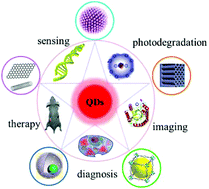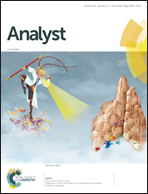Advances in the integration of quantum dots with various nanomaterials for biomedical and environmental applications
Abstract
Quantum dots (QDs) are semiconductor nanocrystals with distinct characteristics of high brightness, large Stokes shift and broad absorption spectra, large molar extinction coefficients, high quantum yield, good photostability and long fluorescence lifetime. The QDs have replaced the conventional fluorophores with wide applications in immunoassays, microarrays, fluorescence imaging, targeted drug delivery and therapy. The integration of QDs with various nanomaterials such as noble metal nanoparticles, carbon allotropes, upconversion nanoparticles (UCNPs), metal oxides and metal–organic frameworks (MOFs) brings new opportunities and possibilities in nanoscience and nanotechnology. In this review, we summarize the recent advances in the integration of QDs with various nanomaterials for biomedical and environmental applications including sensing, bioimaging, theranostics and cancer therapy. We highlight the involved interactions such as fluorescence resonance energy transfer (FRET), plasmon enhanced fluorescence (PEF), and nanometal surface energy transfer (NSET) as well as the synergistic effect resulting from the integration of QDs with nanomaterials. In addition, we discuss the sensing and imaging mechanisms of different strategies and give new insight into the challenges and future direction as well.

- This article is part of the themed collection: Recent Review Articles


 Please wait while we load your content...
Please wait while we load your content...